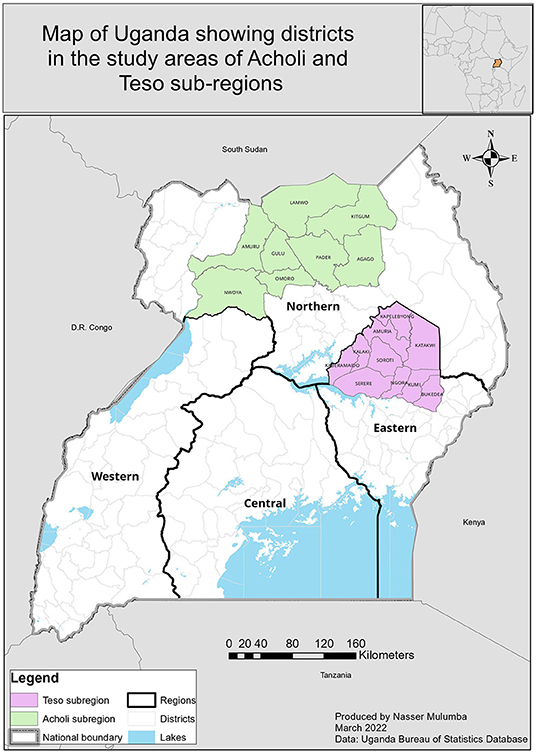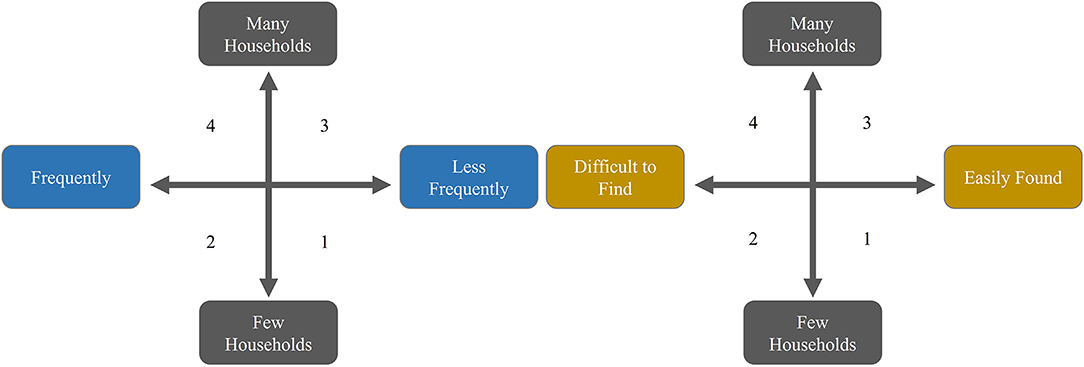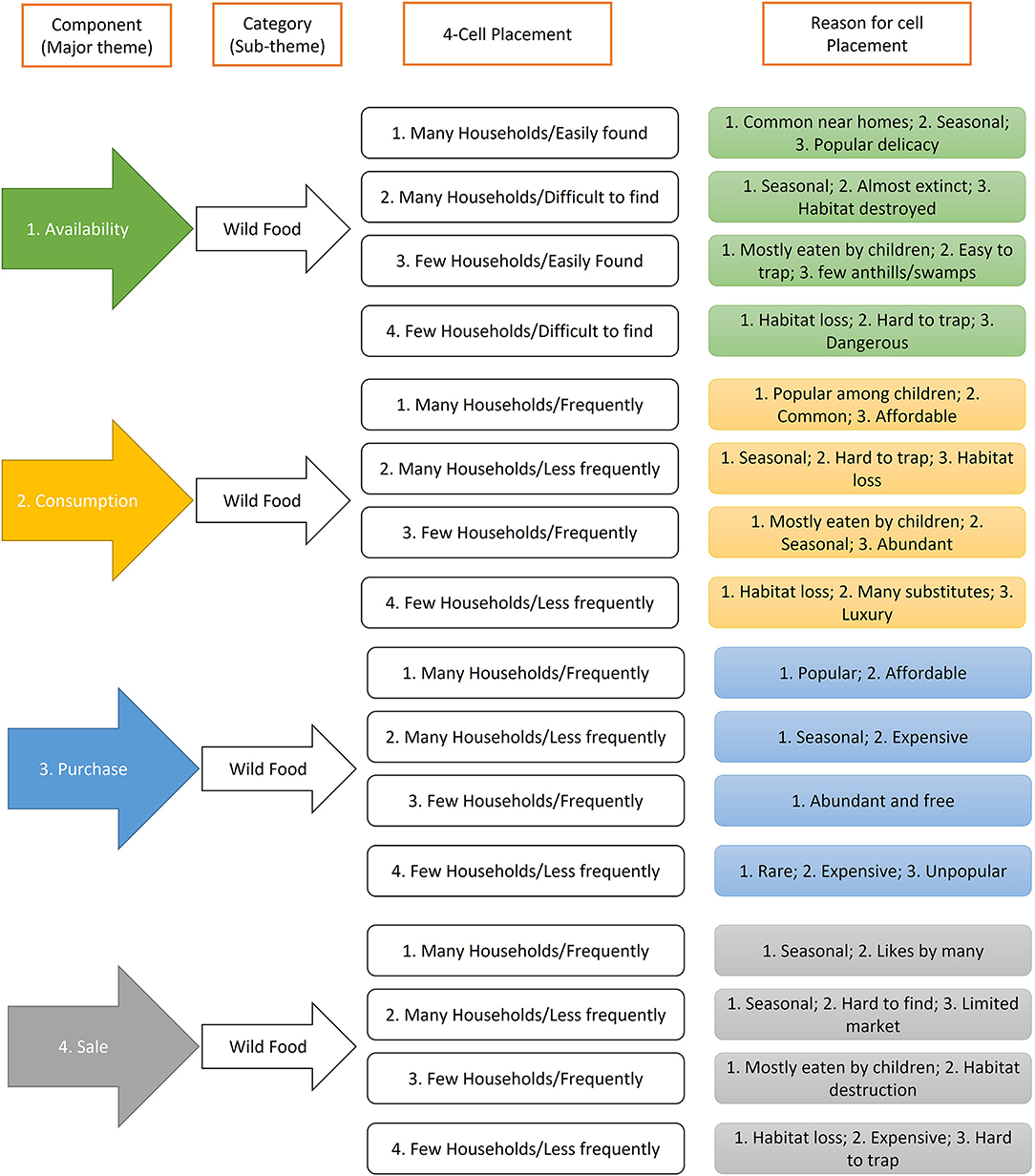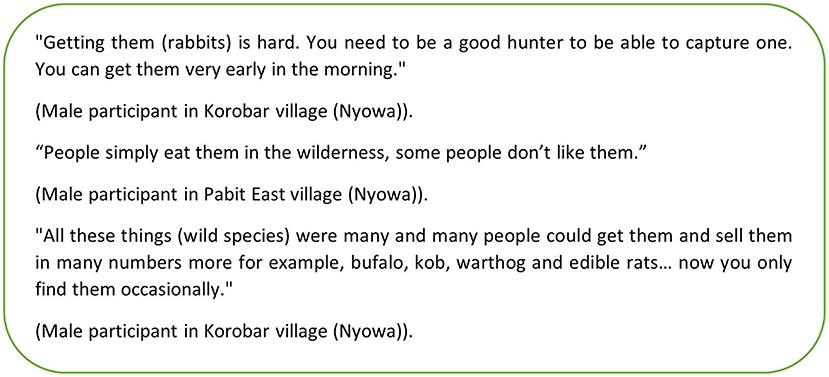- Bioversity International, Kampala, Uganda
Wild foods significantly contribute to the global food basket, and food and nutrition security. Worldwide, wild food species form an integral part of local diets and their widespread assimilation into local food culture suggests an untapped potential to ensure easy availability and access to micronutrients for sustainable food systems. However, wild species are often overlooked within nutrition-related policies, and their levels of availability remain unknown. This paper, therefore, focuses on understanding the changes in availability, access and utilization of wild animal and plant species in Teso and Acholi sub-regions of Uganda. A four-cell agrobiodiversity mapping protocol was applied through focus group discussions to establish the different wild animal and plant species that have played and still play a role within local communities' livelihoods in the two sub-regions. Findings showed that at the time of the study (2017), wild foods were considered to be important contributors to food and nutrition security, although the number of species reported to be available was slightly lower [91 (Acholi) and 103 (Teso)], compared to 20 years ago, where around 109 edible wild species were reportedly available in both the Acholi and Teso sub-regions. Reasons for the decline included (i) increased cultivations, and (ii) natural habitat destruction due to settlements and changes in land ownership. In the latter case, individual owners have further fragmented their land and do not allow villagers to freely participate in hunting and gathering. Lastly, rebel unrest increased feelings of insecurity, and thus prompted a decline in hunting and gathering. The noted presence and contribution of wild foods in Teso and Acholi calls for collective efforts to increase access to knowledge on the value of these wild foods for not only food and nutrition but also for their potential contribution to the social and cultural lives of the people.
Introduction
Hunger and food insecurity remain major global challenges with approximately 768 million people reportedly undernourished and one in three people having inadequate access to food in 2020 (FAO et al., 2021). Although agroecosystems have been modified to ensure plants and animals can be used as food, fiber, fodder, medicines, traps, and weapons, the global food system is currently dominated by only three food crops (wheat, rice and maize), while 5,000 food crops are estimated to exist (Bharucha and Pretty, 2010; FAO, 2021; Padulosi et al., 2021). According to FAO (2019), the drivers of this trend toward such predominance have mainly been: population growth and urbanization; climate change; natural disasters; infestations of pests, diseases and invasive alien species; emerging advanced technologies and innovations; changes in management and use of land and water; overexploitation of available resources; and implementing policies that do not favor conservation. Nevertheless, there still exists substantial evidence that wild foods which are part of neglected and underutilized species (NUS) remain an important component of the global food basket (Bharucha and Pretty, 2010), are playing a significant role in traditional food systems and are still often known to Indigenous and traditional communities (Padulosi et al., 2021). The term wild in this regard implies spontaneous growth outside of cultivated areas (Heywood, 1999). Overall, wild foods can play a vital role in providing food and nutrition security, either by income generation or consumption (FAO, 2019). It is estimated that globally, over one billion people use and incorporate wild foods into their diets (Burlingame, 2000). As such they are integral to traditional food systems, especially when availability is scarce, the household budget is insufficient or market access is difficult (Borelli et al., 2020). Often these wild foods have the same or even superior nutritional profiles compared to their cultivated counterparts (FAO, 2019). Across Asia and Africa, wild foods obtained from non-domesticated species are still an important resource, as a recent review corroborated, reporting agricultural and forager communities using 90–100 different wild species (Bharucha and Pretty, 2010). Ray et al. (2020) report the whole of India has more than 1,000 reported wild edible plant species, yet aggregate three-country national use has been estimated to be between 300 and 800 species for India, Ethiopia and Kenya. In Tanzania, it was established that the Tanzanian Batemi agro-pastoralists use 31 wild species as food, six wild species as thirst quenchers, seven for chewing, two as flavoring, one for honey beer and a further 35 wild, edible plant species have been incorporated into their cultivated systems (Bharucha and Pretty, 2010). However, at the regional and national level, the available food balances that guide policies on trade, aid and the declaration of food crises, notably do not include the contribution made by wild edible species (Bharucha and Pretty, 2010; FAO, 2019). Wild foods are often missing within food composition data and the information on use, conservation and state are limited, as well as financial support and lack of prioritization (Bharucha and Pretty, 2010; FAO, 2019; Borelli et al., 2020). Further, wild foods or NUS, in general, are perceived to be “food for the poor,” or “women's food” (Powell et al., 2014; Hunter et al., 2019; Borelli et al., 2020). This, therefore, enhances the probability of neglecting the provisioning ecosystems and supportive local knowledge systems that sustain food chains around wild foods.
In Uganda, the situation is not different. Uganda ranks among the countries with the greatest diversity of animal and plant species with almost 19,000 recorded species of fauna and flora, even though the country only occupies ~2% of the world's area (land and water) (NEMA, 2016). Still, malnutrition persists in Uganda and 70% of the population experienced moderate to severe food insecurity in 2018–2020 (FAO, 2021). According to NEMA (2016), the National Environment Management Authority, Uganda hosts around 11% (1,063 species) of the world's recorded bird species, which represents half of Africa's bird species It also hosts 7.8 % (345 species) of global mammalian diversity, or 39% of Africa's mammal diversity (NEMA, 2016). In addition, Uganda hosts 19% of Africa's amphibian species, 14% of Africa's reptile species, and 600 different species of fish. A study of indigenous woody species in Agoro-Agu Central Forest Reserve in Northern Uganda identified 86 different woody plant species where 16% are used for consumption within the area (Olanya, 2020). In the Teso-Karamoja region, a total of 100 edible plant species were identified within the forest reserves (Ojelel et al., 2019), while 73 edible plants from 39 families were identified in the Acholi sub-region (Nyero et al., 2021).
In another study carried out in Bulamogi, Uganda, edible wild plants embraced 105 mostly-herbaceous (70.7%) species (Tabuti et al., 2004). Most of the edible plants were found to yield fruits mainly consumed as snacks (41.4%) (Tabuti et al., 2004). However, the wild foods were noted to be infrequently eaten and their consumption was limited to casual encounters, periods of food shortages and as supplements to major food crops (Tabuti et al., 2004). The main reasons reported by Tabuti et al. (2004) for reduced use and neglect of wild foods were (i) the wide variety of introduced cultivated foods and (ii) erosion of traditional knowledge about wild foods (Tabuti et al., 2004). In addition, according to Plumptre et al. (2016), other major threats to biodiversity in Uganda include (i) the increasing human population that fuels a high demand for land in addition to overutilization of the species, and (ii) consequences of climate change that reduce their natural habitats leading to a decline in species or their extinction (Plumptre et al., 2016).
This paper focuses on mapping out the different animal and plant wild food species used within two sub-regions of Uganda, assessing the changes over two distinct time periods in their availability, access to and consumption by smallholder households. The paper aims to understand the changes and factors that influence, the availability, access to and utilization of wild foods for food and nutrition security comparing the two time periods. The past period (1997) was purposively selected, based on the time when the target communities of the Teso sub-region in the East, and Acholi sub-region in Northern Uganda had to leave their homes to live in camps due to the heightened Lord's Resistance Army (LRA) rebellion. The insurgency due to the civil unrest lasted for 20 years (1985–2005), leading to internal displacement and community raids which disrupted the communities' practices related to food production, food acquisition, food handling, food consumption, and other community practices that influence species' conservation. The current period (2017) was selected based on when the communities were back on their farms.
Methodology
Description of the Study Area
The study was conducted in two sub-regions of Uganda, located in the Northern and Eastern regions of the country, named Acholi and Teso, respectively (see Figure 1). Both sub-regions suffered the brunt of insurgency from 1985 to 2005 and in addition, Teso experienced intermittent insecurity between 1990 and 2003. The Acholi region is predominantly occupied by the Acholi ethnic group and is composed of seven districts (Agago, Amuru, Gulu, Kitgum, Lamwo, Nyoya, and Pader). The sub-region occupies a total land area of 29,174 km2, which accounts for 12% of Uganda's total land area (Kasusse et al., 2015; Uganda Bureau of Statistics, 2018). This region is situated at a mean altitude of 1,050 m above sea level and experiences on average an annual rainfall of 1,434 mm with the temperature ranging between 16.8 and 30.5°C while the soil types are mainly petric plinthosols (Acric) and leptosols (Uganda Bureau of Statistics, 2015; Akongo et al., 2016). On the other hand, the Teso sub-region covers a land area of approximately 13,031 square kilometers comprising the districts of Amuria, Bukedea, Kaberamaido, Kapelebyong, Katakwi, Kumi, Ngora, Serere, and Soroti (Dbedia, 2022). The region experiences a humid and hot climate modified by its large swamp area, which mediates the rains over the great plain of Central Karamoja, and the Western slopes of the volcanic mountains of Napak (Kamalinga), Kadam (Debasien), and the Northern side of Elgon (Masaba). In general, the area receives bimodal rainfall averaging between 1,000 and 1,350 mm per annum supporting a predominant grassland savannah vegetation (Egeru, 2012; Okoboi, 2016; Uganda Investment Authority, 2016). Teso sub-region is predominantly inhabited by the Itesot ethnic group, which is the fourth largest ethnic group in the country (Uganda Bureau of Statistics and ICF, 2018).
Due to insurgency occasioned by the LRA rebellion and People's Redemption Army (PRA) in Teso, and the Karamojong cattle raiders, both Acholi and Teso suffered disruption in the social and agrobiodiversity systems which may predicate changes in the current culture. The changes between the past and current traditional systems can affect the way land is governed and household food security status. It is for this reason that the study was conducted in Acholi and Teso.
Selection of Study Sites and Sampling Procedure
The data used to develop this article was part of data collected during a baseline study for the project on “Influences of land impermanence syndrome on conservation and utilization of agrobiodiversity and the subsequent effect on food attitudes and consumption patterns.” The study regions, districts, sub-counties and specific project sites were selected in 2017 following a mixed-method (subjective and objective), multi-stage approach as shown in Figure 2.
Districts were selected based on the opinions of local leaders in both sub-regions. Four districts were purposively selected subjectively considering land security perceptions, selecting one district per region representing an area perceived to be land insecure (regarding land ownership), and one district which is considered to be land secure. After articulation and description of the study objectives by the core project team and through consensus, local leaders in the Acholi sub-region selected Nwoya and Lamwo, while those in the Teso sub-region selected Amuria and Bukedea. In the second sampling stage, four sub-counties per district and in each sub-county, one village (16 villages) were selected following simple random sampling.
Participants and Data Collection
The study employed a qualitative method approach that involved the use of focus group discussions (FGDs), which have the advantage of enabling in-depth information gathering within a considerably shorter period (Gundumogula, 2020). A total of 32 FGDs were targeted between November and December 2017. Group size ranged from 10 to 15 participants and the discussion lasted between 5 and 8 h. Each group was homogenous representing one gender to allow free participation basing on social and gender dynamics of the target communities. Thus, in each village two FGDs (one female and one male) were targeted. Additionally, FGDs comprised a mix of participants of all age groups with minimum age of 18 years and participants older than 35 years old specifically encouraged to participate. Based on an existing FGD methods guide for facilitators and note-takers, developed by the PAR (2018), each session began with a brief introduction of the project, and each participant, and continued after verbal consent was obtained from each person (PAR, 2018). Every FGD was guided by two well-trained research assistants in the local language and was recorded using both notebooks and voice recorders. During the participatory FGDs, the trainers constantly reminded the participants that all their views were important, assured them of high level of confidentiality in data collected and created an open atmosphere for the participants to speak freely by avoiding the dominance of one individual or group of individuals during the discussion directly asking for the opinions of individual or group of individuals whose views seemed not to be coming out during the discussion. As the interest of the current paper is on the wild foods' availability, access and utilization, only FGDs that captured the respective information were considered within the analysis.
Collection of Qualitative Data
Qualitative data on wild foods was collected following the agrobiodiversity mapping protocol, also called four-cell analysis (FCA), developed by Bioversity International in 2006 (Lochetti et al., 2020). In general, the four-cells were established to document the role of agrobiodiversity in the local food system. The tool is created according to two axes, labeled for a relative number of households (many vs. few) and area of cultivation (large vs. small) (see Figure 3), to measure richness (abundance) and evenness (distribution) of local crop diversity, common, unique and rare/endangered varieties or species. The participatory method identifies the most important biological assets that play any role within local-community livelihoods. It also examines the species' utilization across four components: availability/production, consumption, purchase, and sale of various food species (including wild plant and animal species) (Lochetti et al., 2020). Additionally, the element of access to the species and the ease or difficulty with which households in the community find the species are considered, to help indicate the availability or scarcity of a food species. This study examined the current (2017) and past (before 1997) availabilities (access), consumption, sales, and purchases of wild foods. As illustrated in Figure 3, species that are available to many households and easily found (common) would be placed in cell 4, while a species that is available to many households but is difficult to find (unique and vulnerable) would be placed in cell 3. Furthermore, a species that is available to a few households and easily found would be placed in cell 2 (unique and vulnerable), while a species that is available to a few households and difficult to find (rare and under threat) would be placed in cell 1. The same method is applied to consumed, sold and purchased wild food species.
In addition, to help place the species within the 4-cell categories reasons and examples for the different categories were provided which can be seen in Figure 4.
Limitations of the Data
We acknowledge limitations that may have arisen from a possible lack of precision in the language used in the transcripts. The audio recordings were transcribed from Acholi and Itesot to English. Thus, some nuance could have been lost in the translation, although most of this was addressed during the review which involved transcribers exchanging the transcripts and checking to see whether the audio recordings were transcribed as accurately as possible. Also, the list of wild species provided is a mix of the local language and English. The communities were encouraged to name any type of edible species and often members did not know the name in English. Where possible the local names were validated via discussion with colleagues, the local community and available literature (Kimani et al., 2020). However, we acknowledge, that within this research it was a challenge to validate all named species and thus, we list the folk taxonomies, e.g., using the names and explanations provided by the participants instead of the specific scientific taxonomies and traits. Therefore, the number of named species might differ if species could be also identified through scientific taxonomy. Future studies should ensure data backup with scientific names and if possible, obtain pictures of any named food species for further verification. Due to the nature of FGD to let the community speak freely and with the exercise focusing on nine food groups, the information collected at this level focused on species, further studies could be done to move forward and look into varieties within species. In addition, this study presents information gathered only through FGDs it doesn't include details on quantities consumed and level of nutrients.
Data Analysis
In the first analysis step, data on the wild plant and animal species were of interest and the perceived levels of availability, purchase, selling and utilization in diets of each species considering dimensions such as (i) large and small areas; (ii) many and few households; and (iii) more and less frequently following the definitions and specifications of the community in both sub-regions. An example of how the maps looked can be found in Figure 5. The analysis included sorting and looking at the recordings to map the qualitative responses of the participants. In general, the village was considered as the target unit of the analysis. In the second step, the results of four-cell agro-biodiversity data collection were used to compare species' diversity for both the current (2017) and past (1997) periods to ascertain whether there were changes in wild species' diversity and levels of utilization over time, according to folk taxonomy. As reported by Harris and Mohammed (2003) and Ojelel et al. (2019) who classified plant based wild foods according to use category, this study adopted the same approach. The wild foods were later categorized as per what was obtained from the wild and the actual use category especially for plant-based foods. The categories included animal, bird, fish, fruit, insect, leafy vegetable, and stem/root/tuber.
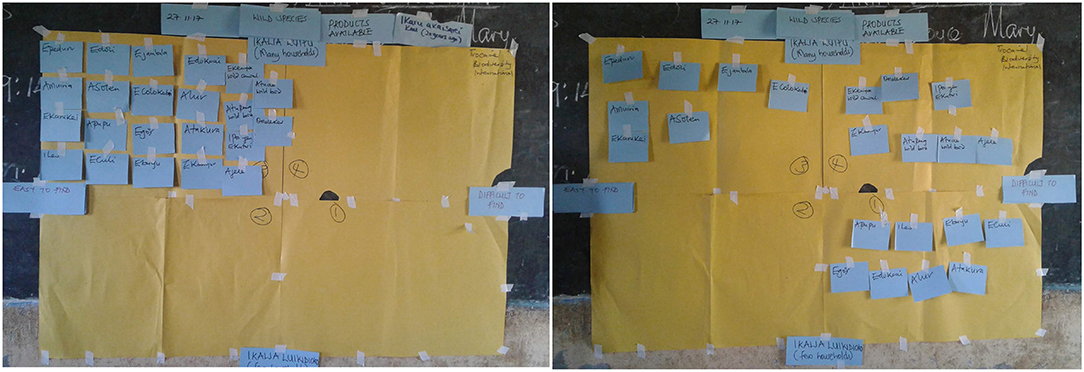
Figure 5. Example of a 4-cell mapping tool for wild species for the past (left) and current (right) period.
Results
In total, FGDs from 16 villages within the four sub-counties were considered within the analysis of wild foods. Fourteen FGDs (eight female and six male) adequately listed information on wild foods in Teso, while nine FGDs were considered for Acholi (three female and six male). Since data collection was not solemnly on wild foods but incorporated 8 other food categories (starchy staples, domesticated animals, fruits, vegetables, legumes, milk and milk products, eggs, oils/fats) in some villages not all data gathered from both male and female groups was complete enough to enable the desired analysis. For instance in one of the districts, Nwoya district, all the complete data came from male FGDs (see Table 1). In the following, we present the results separately according to Teso and Acholi sub-regions.
Wild Species in Teso
The participants within the Teso FGD named a total of 109 different wild species. Of those, 108 were available in the past compared to 103 species in the current period. The prevalence of the foraged wild foods according to species type comparing the past and current periods is summarized in Table 2. A complete list of the local names or folk taxonomy mentioned by the participants can be found in Supplementary Table 1. For both periods, the most listed species types were animals (32%), followed by birds (19%), fruits (18%), and stem/root/tuber (13%). In the past, more animals and uncategorized species were found compared to the current period, but the differences are small.

Table 2. Collected wild food according to species in the past and current period in the Teso and Acholi sub-region.
Four-Cell Dimension on Village Level
In total, at the sub-regional level, 490 different species were identified as available and accessible during the focus group discussions, which are grouped into six different wild species. Thirty species more were named to be accessible in the past compared to the current period. The difference between current and past periods according to the four dimensions displayed in Figure 6 displays how often different wild food species were named by the participants (count). The greatest decline can be seen within the wild animal species. As for the dimension of consumption only three species are named to be consumed today compared to the past, although this does not consider the perception if found by a few or many.
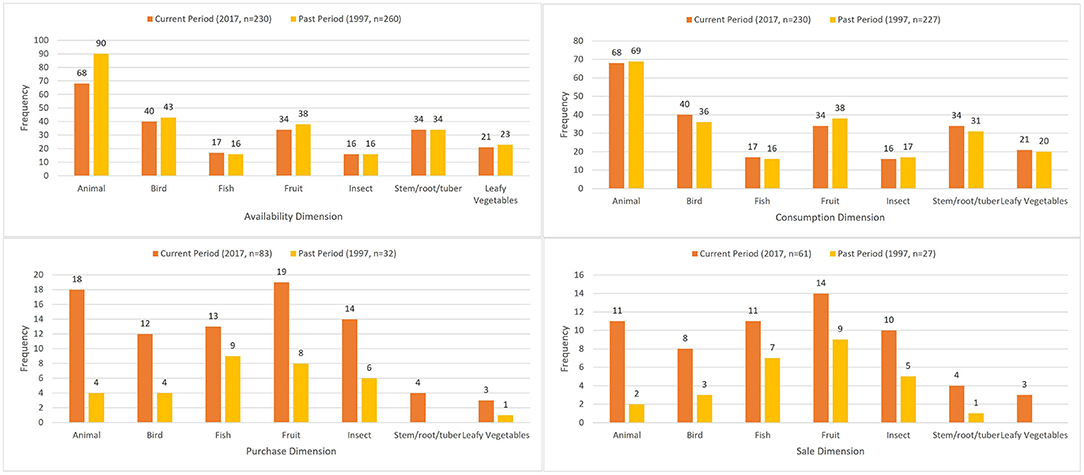
Figure 6. Frequency of wild species according to the 4-dimension in Teso sub-region (availability, consumption, purchase, and sale) (Supplementary Table 2).
Disaggregated per village, almost all of the wild species were available to many households and easy to find during the past period, but this changed over time and the availability in the current period is more diverse and different. Table 3 displays the different species mentioned as being available per village in the Teso sub-region according to the locations and perceptions of the participants. A list of wild species according to folk taxonomy per level of availability can be found in Supplementary Table 4. The results generally revealed a decline in the level of availability of the different wild animal species in Teso over time. For instance, in Atarukot village, 4 animal species were easily available to many households during the current period compared to fifteen species that were easily found by many households during the past period. Similar declining trends were also observed in the other villages in the Teso sub-region.
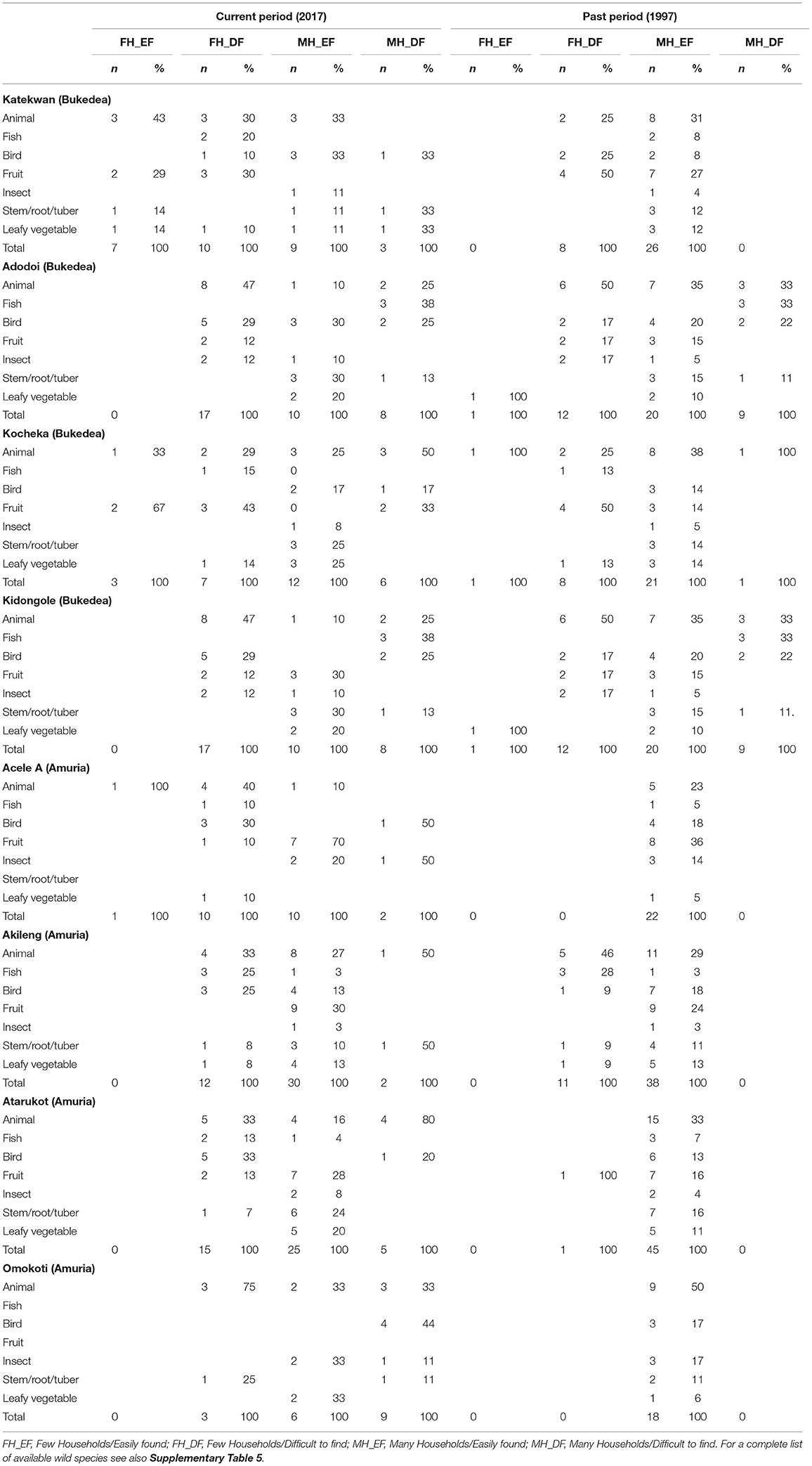
Table 3. Availability species according to the 4-cell placement for the current and past period for Teso sub-region according to village.
Most of the participants across the FGD mentioned that the wild species were difficult to find during the current period and only available for a few households, displaying that most of the common wild species in the past are rare and under threat today. This was mostly attributed to the reduction in the size of the communal land from which most of the wild species were gathered/ hunted. One respondent explained that in the past the villages had high vegetation and the number of villagers was smaller, hence the wild animals had more space and were also easier to find (see Quote in Figure 7).
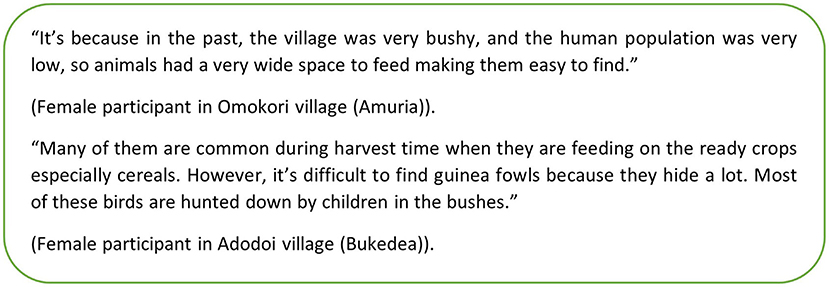
Figure 7. Quotes of female focus group discussion participants about availability in Teso sub-region.
Most of the animal species which were hunted for their meat were reported to be easily available during the past period often by many households but only in a few communities, while mostly in the Bukedea district male participants indicated that certain types of animal species are difficult to access.
Similarly, the level of consumption of wild species was high in the past with most of the species being consumed by many households frequently since they were abundant and easy to find (see also Supplementary Table 3). While within the current period (2017), participants across the Teso FGD reported a decline in the level of consumption of wild species, which was attributed to the reduction in their natural habitats making them hard to find in most of the communities. In 2017, the female and male participants across the Teso sub-region reported that around 15 different animal species were consumed frequently, while 18 species were identified as having been frequently consumed in the past period. A complete list displaying the frequencies of wild species according to the village, 4-cell placement and gender is displayed in Supplementary Table 5.
A list of wild species according to folk taxonomy per level of purchase and sale for the Teso sub-region according to the village can be found in Supplementary Tables 6, 7, while on species level it can be found in Supplementary Table 3. Generally, the level of trade, meaning sales or purchase of wild species was low during the past period and higher in the current periods for different reasons. In the past, almost all households had easy access to the wild species as sufficient numbers existed. Thus, there was no market for them, but during the current period, almost all the wild species especially the animals and birds are proving difficult to find and are only available in small numbers, so they rarely come up for sale/ purchase. One participant told us if someone is lucky enough to hunt a wild animal it is used for own consumption (see quote Figure 8).
Wild Species in Acholi
A slightly smaller number of wild species was reported within the FGD in the Acholi sub-region. In total 97 different wild species were named by the different villages. In the past period, 97 compared to 91 species in the current period were available, which were categorized into six different species types (see also Table 2). A complete list of named wild species in the past and present including their categorization can be found in the Supplementary Table 1. In general (past and current), although as shown in Table 2, there were about 6 categories of wild species, the most mentioned wild foods were animals (35%), followed by fruits (24%), insects (14%), and birds (13%). Interestingly no fish species were mentioned in any of the groups in Acholi, while in the Teso sub-region 5 different fish species were mentioned and compared to five different wild species in the Teso sub-region.
Four Cell Dimensions at the Village Level
In general, fewer species were easily found in Acholi compared to the Teso sub-region. Overall, disregarding the perception/categorization of the wild species 279 different wild species were accessible, as displayed in Figure 9. In the past, more species types were easily found by many households across the districts (Table 4). Although most of the wild species were found in only a few communities, their level of availability was high in those communities where they were found. In Mudu West, Iromo, and Ngomoromo villages, in Lamwo district, the number of wild animal species easily available to many households has not changed over time. On the contrary, Bwobonam B, Lamoki and Korobar villages in Nyowa districts all reported a decline in the number of animal species easily available to many households over time. However, Bwobonam B and Korobar villages in Nwoya and Alenyo south in Lamwo reported having more wild fruits being available to many households easily in the current period compared to the past.
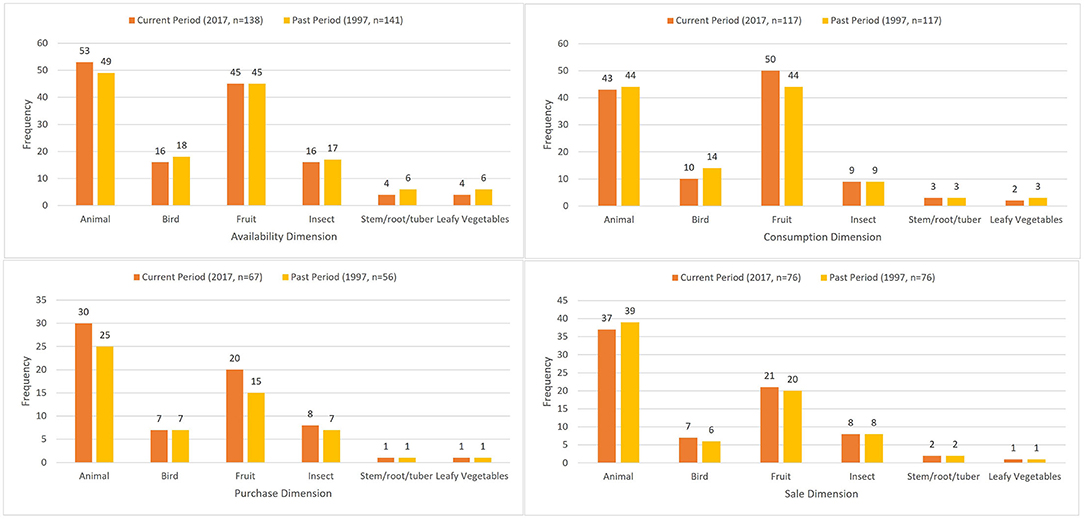
Figure 9. Frequency of wild species according to the 4-dimension in Acholi sub-region (availability, consumption, purchase, and sale) (Supplementary Table 2).
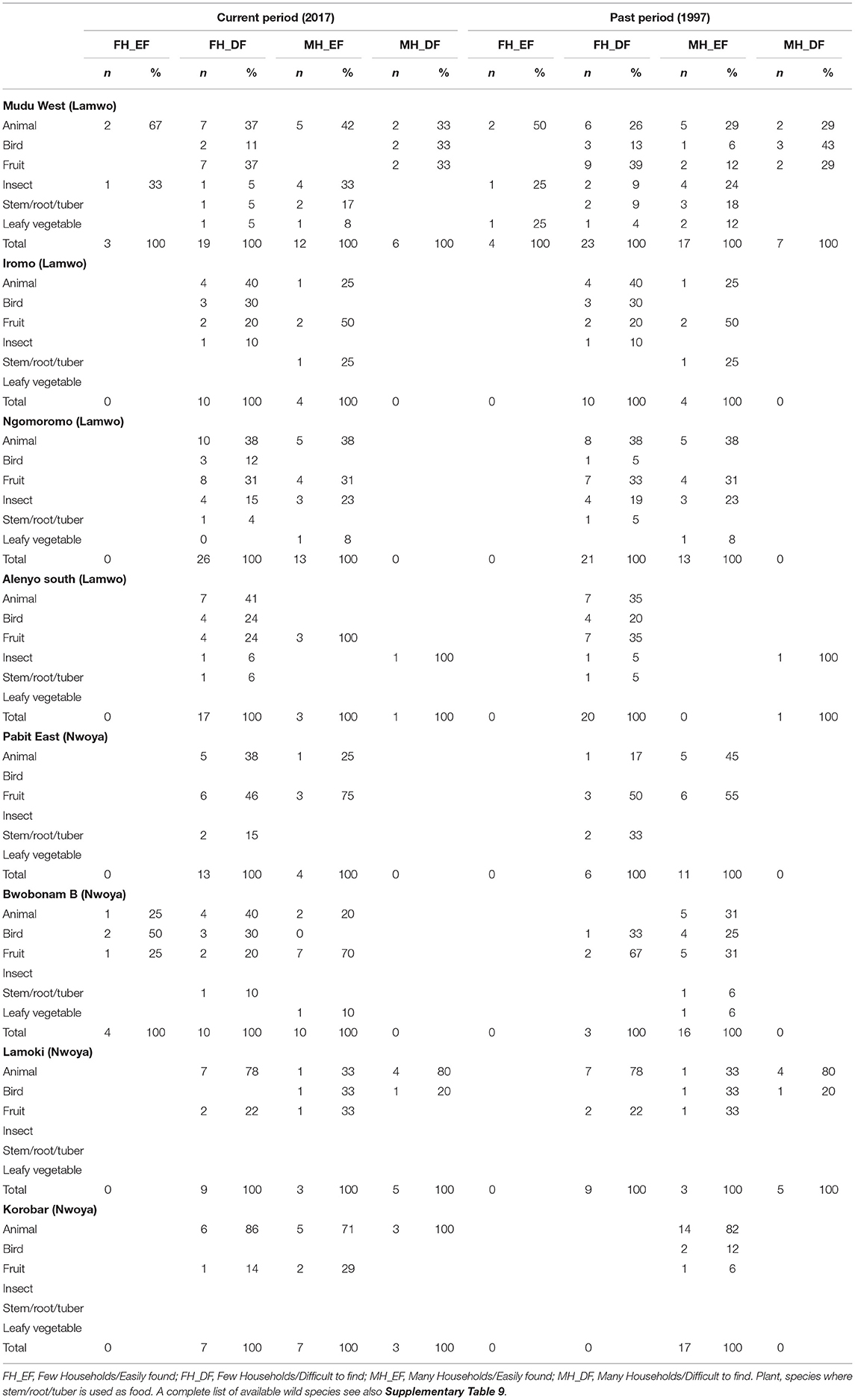
Table 4. Availability species according to the 4-cell placement for the current and past period for Acholi sub-region according to village.
A male participant in Nyowa district argued that the level of availability of most wild species has declined because most of their habitat has been destroyed for cultivation. Many wild species, especially animals were easily available in the past as the hunting restrictions were not enforced due to the level of political insecurity (see quote in Figure 10).
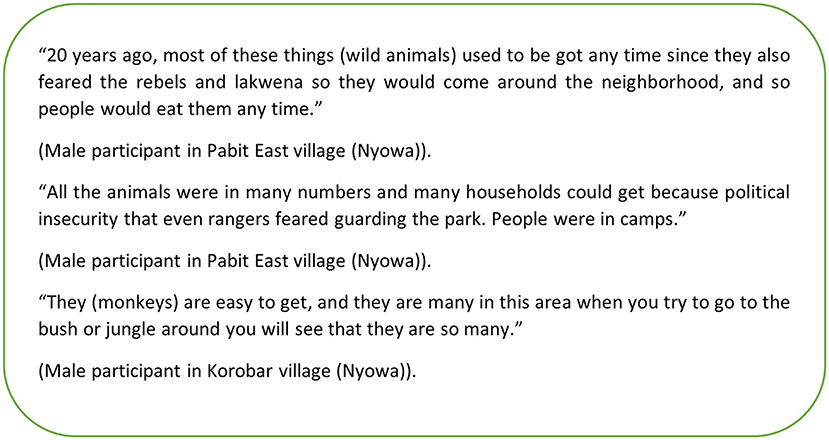
Figure 10. Quote of a male focus group discussion participant about availability in Acholi sub-region.
Similarly, the level of consumption of wild species had declined considerably over time due to restrictions on hunting wild animals. Consumption, purchase, and sale according to the 4-cell placement for the current and past period for Acholi sub-region according to the village and aggregated form can be found in Supplementary Table 8. Today, around 12 different wild species were named as being consumed by many households frequently, while over 35 different types of wild species were consumed by many in the past (Supplementary Table 10). A complete list of wild species according to folk taxonomy for purchase and sale according to the village can be found in Supplementary Tables 11, 12.
Trade was higher in the current period compared to the past, but less frequently and for a few households. As reasons, several participants across the Acholi sub-region groups indicated, additionally, that most of the communal land, where their natural habitat was located, has been converted into farmland and agricultural production. This has made it harder to access wild species, leading to less frequent consumption and a reduction in their sales/purchase levels. Similarly, some wild animals are difficult to hunt requiring rare, highly-specialized skills. Today these skills are almost lost within the community due to poor inter-generational knowledge transfer and sharing. In addition, the high level of insecurity due to rebel activities has limited people's access to the different wild species. Another participant in Pabit east noted that due to past poor security and surveillance, wild animals were easily available when park rangers were less rigorous than they are currently (see quotes in Figure 11).
Discussion
Within this paper, we have considered the changes in the availability and utilization of wild food species over time within two sub-regions in Uganda. Our study mentions more than 100 different edible wild plant and animal species in both regions considering the two time periods (2017 and 1998). It further confirms that wild foods still play a major role in our food systems. However, the number reported here is significantly lower than what has been reported in a number of studies. In a study carried out in the Oraon tribal community in Jharkhand, India, more than 130 varieties of indigenous foods were identified, many of which were rich sources of micronutrients (Ghosh-Jerath et al., 2015). In another study that considered the whole of India, more than 1,000 wild edible plant species were reported (Ray et al., 2020). This high number could be because the study was carried out in a significantly larger geographical area considering the size of India than our study area of 8 sub-counties in 4 districts of Uganda. Nevertheless, all three studies acknowledge that wild food species form an integral part of local diets and their widespread assimilation into local food culture suggests an untapped potential to ensure easy availability and access to micronutrients for sustainable food systems (Ghosh-Jerath et al., 2015; Ray et al., 2020). In addition, in the India study, more categories of plant wild species were observed such as leafy shoots, seeds, and legumes while in this study the plant-based wild foods were fruits, other plant materials (stem, root, tubers) and leafy vegetables. This difference could be because Indian diets are more leafy vegetable/plant-based thus increased focus and utilization also contributes to an increase in conservation and availability. In another study carried out in Tanzania, a total of 92 species of wild (or spontaneous growing/uncultivated) foods were reported in the dietary surveys conducted between March and May and September and October 2009 (Powell et al., 2013).
The availability and use of wild foods can be influenced by several factors, some of which boost or reduce the use of wild foods, while the impact of others is very ambiguous and based on a particular context (Bharucha and Pretty, 2010). This study aimed to understand the level of availability and utilization of wild foods considering the two time periods. Participants were able to mention their perceived factors that either negatively or positively influenced availability and utilization. The availabilities and numbers of wild foods were indicated to be negatively influenced by increased clearing of natural habitats to pave the way for cultivation and establishing new settlements to accommodate population increases. In addition, the rearing of newly introduced and exotic species has reduced interest in natural habitats and foraging for wild foods. Access to knowledge has been reported as a major factor influencing access to and use of wild foods. Studies have shown that foraging, hunting and trapping knowledge and skills have dwindled due to trans-generational information erosion (Tabuti et al., 2004; Ali-Shtayeh et al., 2008; Bharucha and Pretty, 2010). Our study corroborates these findings, whereby participants clearly indicated a lack of knowledge on how to sustainably and successfully trap, and hunt wild animals, [“you have to have good hunting skills which most of the current generation do not have”]. Bharucha and Pretty (2010) further indicate that the quantity and quality of indigenous knowledge on wild foods especially edible plants are closely related to the traditions, environment and cultural heritage of each country. Ali-Shtayeh et al. (2008) state that the observed decline in wild foods gathering is due to socioeconomic conditions that lead to lifestyle changes and road networks needing space.
The expansion of intensive agriculture limits the capacity of ecosystems to sustain food production and at the same time maintain wild-food species' habitats, which has restricted the availability of wild foods (Bharucha and Pretty, 2010). In addition, the commercialization of agriculture, an important driver of land-use change, has decreased reliance on wild foods, thus eroding the knowledge and skills associated with wild food species conservation, sustainable trapping/hunting/gathering and sustainable utilization (Bharucha and Pretty, 2010), which was also confirmed during the focus group discussions.
In addition, the relatively rapid turnaround of intensive agriculture leads to easier access to and higher availability of commercialized agricultural products, in addition to negative perceptions toward consumption of wild edible foods. Wild foods are perceived to be for the poor and thus are associated with poverty and backwardness (Meldrum and Padulosi, 2017; Padulosi et al., 2022). Other drivers documented include agricultural and land use policy, infrastructure development, and widened access to markets that have been implicated in the declines of wild species in Thailand and China (Bharucha and Pretty, 2010). Although land and agriculture were identified as drivers in this study it was not in relation to policies. Infrastructure, market access and association with poverty did emerge as drivers of wild species' loss during the discussions.
The continued reporting of high levels of food insecurity and malnutrition among communities dependent on forestry, natural habitats and agriculture for food and nutrition makes it important to understand current trends for wild foods. As wild food species offer a potentially critical role as a buffer against stress, especially during lean seasons or calamities such as famine, and natural disasters (floods, fires, insect infestation on farms). This also applies when caught up in pandemics such as COVID-19 which results in restrictions that influence livelihoods activities such as farming and marketing. In addition, the innate resilience of wild species to rapid climate change, and other harsh conditions which are often lacking in exotic species', means that they could play an increasingly important role in sustaining the diet and food systems of communities reliant on forests, natural habitats and production for their food and nutrition (Bharucha and Pretty, 2010).
Greater access to and availability of wild food species are often linked to more diverse diets, thus contributing to food and nutrition security and the livelihoods of rural communities (Powell et al., 2015). The noted presence of wild foods and their potential to contribute to food and nutrition security in the Teso and Acholi sub-region necessitated the reinforcement of strategies that support the preservation and conservation of wild foods and related agrobiodiversity. This study supports a call for collective efforts and actions for more capacity building and reinforcement of policies that enhance agrobiodiversity, forest conservation and functional ecosystem services. Synergies and linkages between wildlife and forestry should be developed and sustainably harnessed. Policies and laws directed toward characterizing documenting and managing the available biodiversity should be prioritized and enforced. This is especially true for wild foods, with an emphasis on their multi-faceted value, sustainable utilization and conservation. Additionally, the communities' access to user-friendly, timely information should be ensured, through motivated and well-equipped extension service providers. and functioning extension service providers. To add value to the folk taxonomic data, the authors have proposed a follow-up MSc study to identify the scientific names of all species listed, for subsequent analysis.
Conclusion
This study has highlighted the importance of wild animal and plant species in Ugandan food and nutrition security. Aligning with other studies, our research acknowledges that wild food species form an integral part of the diet and their widespread assimilation into local food culture suggests an untapped potential to ensure easy availability and access to micronutrients for sustainable food systems (Ghosh-Jerath et al., 2015; Ray et al., 2020).
Our study findings indicate that over the last two decades there have been significant declines in wild food availability, access, consumption, and sales. It has been revealed that the reasons for the decline include increased cultivations and natural habitat destruction due to settlements and changes in land ownership. In the latter case, individual owners have further fragmented their land and do not allow villagers to freely participate in hunting and gathering. Lastly, rebel unrest increased feelings of insecurity, and thus prompted a decline in hunting and gathering. The noted presence and contribution of wild foods in Teso and Acholi calls for collective efforts to increase access to knowledge on the value of these wild foods for not only food and nutrition but also for their potential contribution to the social and cultural lives of the people.
Data Availability Statement
The raw data supporting the conclusions of this article will be made available by the authors, without undue reservation.
Ethics Statement
Ethical review and approval was not required for the study on human participants in accordance with the local legislation and institutional requirements. The patients/participants provided their written informed consent to participate in this study during group discussions. The necessary permissions were also obtained from administrative leaders.
Author Contributions
BE designed the study, initiated the publication, coordinated, and led the improvement of the manuscript throughout the writing process. AF mainly worked on the review of related literature, organizing the findings, putting together the discussion area, and ensuring the citation and reference section is accurately put. MN carried out the transcription of the FGD data and carried out data analysis put together the tables and summaries and engaged in the review of the manuscript. All authors contributed to the article and approved the submitted version.
Funding
This research was funded by the Drivers of Food Choice (DFC) Competitive Grants Program, which is funded by the UK Government's Foreign, Commonwealth and Development Office and the Bill & Melinda Gates Foundation, and managed by the University of South Carolina, Arnold School of Public Health, USA (Grant number OPP#1110043).
Author Disclaimer
The views expressed do not necessarily reflect the UK Government's official policies or more generally the policies of the donor.
Conflict of Interest
The authors declare that the research was conducted in the absence of any commercial or financial relationships that could be construed as a potential conflict of interest.
Publisher's Note
All claims expressed in this article are solely those of the authors and do not necessarily represent those of their affiliated organizations, or those of the publisher, the editors and the reviewers. Any product that may be evaluated in this article, or claim that may be made by its manufacturer, is not guaranteed or endorsed by the publisher.
Acknowledgments
This Project was implemented by a team of Scientists and program officers from Bioversity International and TRÓCAIRE Uganda. The implementing partners are indebted to all the parents, children, and households that participated in this study and to the field guides, village and/or clan leaders, and district leaders that offered their kind support and advice to the TRÓCAIRE-BIOVERSITY implementing team. The authors gratefully acknowledge the editorial support of Vincent Johnson, on behalf of the Bioversity-CIAT Alliance science writing service.
Supplementary Material
The Supplementary Material for this article can be found online at: https://www.frontiersin.org/articles/10.3389/fsufs.2022.836212/full#supplementary-material
References
Akongo, G. O., Gombya-Ssembajjwe, W., Buyinza, M., and Bua, A. (2016). Effects of climate variability on technical efficiency of rice in Acholi and Lango Sub-regions, Uganda. J. Econ. Sustain. Dev. 7, 126. Available online at: https://iiste.org/Journals/index.php/JEDS/article/view/31239 (accessed February 10, 2022).
Ali-Shtayeh, M. S., Jamous, R. M., Al-Shafie', J. H., Elgharabah, W. A., Kherfan, F. A., Qarariah, K. H., et al. (2008). Traditional knowledge of wild edible plants used in palestine (Northern West Bank): a comparative study. J. Ethnobiol. Ethnomed. 4, 13. doi: 10.1186/1746-4269-4-13
Bharucha, Z., and Pretty, J. (2010). The roles and values of wild foods in agricultural systems. Philos. Trans. R. Soc. Lond. B Biol. Sci. 365, 2913–2926. doi: 10.1098/rstb.2010.0123
Borelli, T., Hunter, D., Powell, B., Ulian, T., Mattana, E., Termote, C., et al. (2020). Born to eat wild: an integrated conservation approach to secure wild food plants for food security and nutrition. Plants 9, 1299. doi: 10.3390/plants9101299
Burlingame, B. (2000). Wild nutrition. J. Food Compos. Anal. 13, 99–100. doi: 10.1006/jfca.2000.0897
Dbedia (2022). About: Teso Sub-Region. Available online at: https://dbpedia.org/page/Teso_sub-region (accessed February 10, 2022).
Egeru, A. (2012). Role of indigenous knowledge in climate change adaptation: a case study of the Teso Sub-Region, Eastern Uganda. IJTK 11, 217–224. Available online at: http://nopr.niscair.res.in/handle/123456789/13849 (accessed February 10, 2022).
FAO (2019). The State of the World's Biodiversity for Food and Agriculture, eds J. Bélanger, and D. Pilling (Rome: FAO).
FAO (2021). Maximizing Nutrition in the Forestry Sector in Uganda: In Brief. Rome: FAO. Available online at: https://www.fao.org/publications/card/en/c/CB5606EN/ (accessed January 30, 2022).
FAO., IFAD., UNICEF., WFP., and WHO (2021). The State of Food Security and Nutrition in the World 2021. FAO; IFAD; UNICEF; WFP; WHO, Rome, Italy.
Ghosh-Jerath, S., Singh, A., Kamboj, P., Goldberg, G., and Magsumbol, M. S. (2015). Traditional knowledge and nutritive value of indigenous foods in the oraon tribal community of Jharkhand: an exploratory cross-sectional study. Ecol. Food Nutr. 54, 493–519. doi: 10.1080/03670244.2015.1017758
Gundumogula, M. (2020). Importance of focus groups in qualitative research. Int. J. Hum. Soc. Stud. 8, 299–302. doi: 10.24940/theijhss/2020/v8/i11/HS2011-082
Harris, F., and Mohammed, S. (2003). Relying on nature: wild foods in Northern Nigeria. Ambio 32, 24–29. doi: 10.1579/0044-7447-32.1.24
Heywood, V. H. (1999). Use and Potential of Wild Plants in Farm Households. Rome: FAO Farm System Management Series; FAO.
Hunter, D., Borelli, T., Beltrame, D. M. O., Oliveira, C. N. S., Coradin, L., Wasike, V. W., et al. (2019). The potential of neglected and underutilized species for improving diets and nutrition. Planta 250, 709–729. doi: 10.1007/s00425-019-03169-4
Kasusse, M. L., Tumwesigye, N. M., Aisu, S., Matovu, J. K. B., and Wanyenze, R. (2015). Effectiveness of the credit-line approach for support of CD4 equipment functionality in northern Uganda. Afr. J. Lab. Med. 4, 5. doi: 10.4102/ajlm.v4i1.234
Kimani, A., Mayer, A., and Swiderska, K. (2020). Putting Indigenous Foods and Food Systems at the Heart of Sustainable Food and Nutrition Security in Uganda. London; The Hague: IIED and Hivos. Available online at: https://pubs.iied.org/sites/default/files/pdfs/migrate/16663IIED.pdf (accessed May 27, 2022).
Lochetti, G., Meldrum, G., Kennedy, G., and Termote, C. (2020). Seasonal Food availability calendar for improved diet quality and nutrition: Methodology guide. Alliance of Bioversity International and CIAT. Available online at: https://cgspace.cgiar.org/handle/10568/108914 (accessed December 2, 2021).
Meldrum, G., and Padulosi, S. (2017). “Neglected no more: leveraging underutilized crops to address global challenges,” in Routledge Handbook of Agricultural Biodiversity eds, D. Hunter, L. Guarino, C. Spillane, P. C. McKeown (London: Routledge), 710. doi: 10.4324/9781317753285-19
NEMA (2016). National Biodiversity Strategy and Action Plan II (2015-2025). Kampala: National Environment Management Authority.
Nyero, A., Achaye, I., Odongo, W., Anywar, G., and Malinga, G. M. (2021). Wild and semi-wild edible plants used by the communities of Acholi sub-region, Northern Uganda. Ethnobot. Res. Applic. 21, 1–12. doi: 10.32859/era.21.16.1-12
Ojelel, S., Mucunguzi, P., Katuura, E., Kakudidi, E. K., Namaganda, M., and Kalema, J. (2019). Wild edible plants used by communities in and around selected forest reserves of Teso-Karamoja region, Uganda. J. Ethnobiol. Ethnomed. 15, 3. doi: 10.1186/s13002-018-0278-8
Okoboi, J. A. (2016). The Genesis, Development and Impact of Cattle Rustling in Teso Sub-Region, 1600-2001: A Case of Katakwi District, Uganda. Available online at: https://ir-library.ku.ac.ke/handle/123456789/15355 (accessed February 10, 2022).
Olanya, P. B. (2020). Use Patterns of Indigenous Woody Species in and Around Agoro-Agu Central Forest Reserve, Northern Uganda. J. Ecosys. Ecograph. 10, 269. Available online at: https://www.omicsonline.org/open-access/use-patterns-of-indigenous-woody-species-in-and-around-agoroagu-centralforest-reserve-northern-uganda.pdf
Padulosi, S., King, E. D. I. O., Hunter, D., and Swaminathan, M. S, (eds). (2022). Orphan Crops for Sustainable Food and Nutrition Security: Promoting Neglected and Underutilized Species. Abingdon; Oxon; New York, NY: Routledge. doi: 10.4324/9781003044802
Padulosi, S., Meldrum, G., King, E. D. O., and Hunter, D. (2021). “NUS: what they are and why we need them more than ever,” in Orphan Crops for Sustainable Food and Nutrition Security: Promoting Neglected and Underutilized Species, eds, D. Hunter, L.Guarino, C. Spillane, and P. C. McKeown (London: Taylor and Francis Group), 3–18. doi: 10.4324/9781317753285
PAR (2018). Assessing Agrobiodiversity: A Compendium of Methods. Rome: Platform for Agrobiodiversity Research. Available online at: https://static1.squarespace.com/static/5cd00f2c94d71a802807347f/t/5e431f667e88114bfbbee386/1581457302378/Assessing-Agrobiodiversity-A-Compendium-of-Methods-lowres.pdf (accessed March 17, 2022).
Plumptre, A. J., Nixon, S., Kujirakwinja, D. K., Vieilledent, G., Critchlow, R., Williamson, E. A., et al. (2016). Catastrophic decline of world's largest primate: 80% loss of grauer's gorilla (Gorilla beringei graueri) population justifies critically endangered status. PLoS ONE 11, e0162697. doi: 10.1371/journal.pone.0162697
Powell, B., Maundu, P., Kuhnlein, H. V., and Johns, T. (2013). Wild foods from farm and forest in the East Usambara Mountains, Tanzania. Ecol. Food Nutr. 52, 451–478. doi: 10.1080/03670244.2013.768122
Powell, B., Ouarghidi, A., Johns, T., Ibn Tattou, M., and Eyzaguirre, P. (2014). Wild leafy vegetable use and knowledge across multiple sites in Morocco: a case study for transmission of local knowledge? J. Ethnobiol. Ethnomed. 10, 34. doi: 10.1186/1746-4269-10-34
Powell, B., Thilsted, S. H., Ickowitz, A., Termote, C., Sunderland, T., and Anna, H. (2015). Improving diets with wild and cultivated biodiversity from across the landscape. Food Sec. 7, 535–554. doi: 10.1007/s12571-015-0466-5
Ray, A., Ray, R., and Sreevidya, E. A. (2020). How many wild edible plants do we eat—their diversity, use, and implications for sustainable food system: an exploratory analysis in India. Front. Sustain. Food Syst. 4, 56. doi: 10.3389/fsufs.2020.00056
Tabuti, J. R. S., Dhillion, S. S., and Lye, K. A. (2004). The status of wild food plants in Bulamogi County, Uganda. Int. J. Food Sci. Nutr. 55, 485–498. doi: 10.1080/09637480400015745
Uganda Bureau of Statistics (2015). 2015 Statistical Abstract. Kampala: UBOS Available online at: http://library.health.go.ug/sites/default/files/resources/UBOS%20Statistical%20Abstract%202015.pdf (accessed February 10, 2022).
Uganda Bureau of Statistics (2018). Uganda National Household Survey (UNHS) 2016/2017 Report. Kampala: UBOS.
Uganda Bureau of Statistics., and ICF (2018). Uganda Demographic and Health Survey 2016. Kampala; Rockville, MD: UBOS and ICF.
Uganda Investment Authority (2016). Teso-Investment-Profile. Kampala: Uganda Investment Authority. Available online at: https://www.ugandainvest.go.ug/wp-content/uploads/2016/02/Teso-Investment-Profile.pdf (accessed February 10, 2022).
Keywords: wild species, utilization, food and nutrition security, changes over time, Uganda, wild plant species for food, wild animal species for food
Citation: Ekesa B, Fongar A and Nasser M (2022) Access to and Utilization of Wild Species for Food and Nutrition Security in Teso and Acholi Sub-regions of Uganda. Front. Sustain. Food Syst. 6:836212. doi: 10.3389/fsufs.2022.836212
Received: 15 December 2021; Accepted: 30 May 2022;
Published: 28 June 2022.
Edited by:
Sofia Boza, University of Chile, ChileReviewed by:
Margaret Pasquini, Colombian Corporation for Agricultural Research (AGROSAVIA), ColombiaChris Vogliano, United States Agency for International Development, United States
Copyright © 2022 Ekesa, Fongar and Nasser. This is an open-access article distributed under the terms of the Creative Commons Attribution License (CC BY). The use, distribution or reproduction in other forums is permitted, provided the original author(s) and the copyright owner(s) are credited and that the original publication in this journal is cited, in accordance with accepted academic practice. No use, distribution or reproduction is permitted which does not comply with these terms.
*Correspondence: Beatrice Ekesa, Yi5la2VzYUBjZ2lhci5vcmc=
 Beatrice Ekesa
Beatrice Ekesa Andrea Fongar
Andrea Fongar Mulumba Nasser
Mulumba Nasser